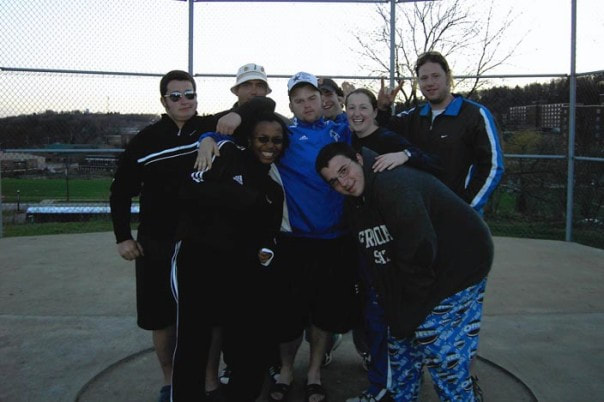|
Opportunities Conference championship season is upon us! All the training, sets, reps, and throws since August have prepared us for this moment in time. The moment to throw well when it matters most, during the championship season. I venture to guess that not all championships are won and lost at the meet. I venture to say that these championships are won and lost well before the championship meet arrives. I guess that these championships are won and lost when the fall semester begins, maybe sooner. I say this because I’ve attended my fair share of conference, regional, and national championship meets to understand that anything can happen when the top throwers are vying for the coveted championship win. Some might say these meets are stressful and difficult to manage for some athletes. For others, many throwers achieve seasonal best marks and even personal best marks when it matters most. For those individuals, I say that they take advantage of the opportunities bestowed upon them in those situations. I fell victim to those high stress situations on two different occasions in my own collegiate throwing career. In 2002 and 2004, I was the top seeded thrower at our indoor conference championships for the weight throw. I felt as though I was prepared for the situation at hand, but unfortunately I was not. In 2002 I finished second with a personal best throw in round 5. The eventual champion hit a personal best in round 6. I could not respond. In 2004, my senior year, I was also seeded first. I threw 15cm below my personal best. I finished 4th. The top 3 individuals all hit personal best throws in that competition. If I would have hit a personal best, I would have moved up to 2nd. I may have won depending on how the other throwers would have reacted to me setting a personal best in the finals. Yet at our 2003 indoor conference championships I was seeded 3rd coming into the meet. I hit a personal best throw in round 3. I was the top thrower entering the finals. I hit another personal best in round 4. I could not catch up to the thrower that eventually won the competition. He hit a personal best in round 5. I could not respond in round 6. However, reflecting back on those experiences has led me to realize that my 2003 2nd place finish is more valuable to me than any other indoor conference championships I competed in during my collegiate career. I was not expected to throw far, took advantage of an opportunity in which the top 2 seeded individuals did not perform well, and believed I was going to sneak away with a victory. The 5th seeded individual had other plans, too. These opportunities are presented to us in the throwing world at every competition. Every meet. Every throw is an opportunity for ourselves to meet a goal, realize a dream, and aspire to be great. As cliche as it sounds. As a coach, I’ve sat on both sides of the conversation with my athletes. Those that took advantage of an opportunity and those that failed to do so. A couple of specific instances stand out, one situation at SUNY Fredonia and one at Nazareth College. In the spring of 2006 I was coaching a group of throwers that had far exceeded the expectations I had of them at the beginning of the season. Led by two upperclassman transfer throwers, the men’s squad single handedly removed me from the top 10 list of the weight and hammer throw. What sticks out most is the way a freshman female thrower handled the outdoor conference championships that season. In what turned out to be a coming out party for arguably one of the most successful athletic careers at SUNY Fredonia, Julia Hopson won the hammer throw that day. She beat a senior thrower that had watched the hammer championship slip her grasp the prior two years. Julia took advantage of an opportunity presented to her, set a personal best when others were faltering, and came within a meter of breaking our then school record of 52m in the hammer. She set a personal best by over 3m on a day that the throwing Gods had decided was not going to be suited for outstanding performances. Julia surprised everyone and came away with the victory. Her first of 4 consecutive SUNYAC hammer championships. About 7 years later I experienced it again. This time I was a first year coach at Nazareth College with two freshmen male throwers competing at our conference championships at St. Lawrence University. Both throwers competed well the weekend before at our outdoor E8 Championships. At this meet they were both seeded outside the top 10, competing in the first flight of 2 flights. One day 1 of the competition, freshman thrower Luis Rivera set a personal best in flight 1 of the men’s hammer competition, throwing just over 41m. He finished 2nd in his flight of 10. We knew that he needed to beat at least 9 of the throwers in flight 2 to make the finals. It didn’t seem realistic because everyone in flight 2 was seeded over 44m. Well, if you guessed that he would end up making the finals, you are right. He entered the finals seeded 9th of 9th throwers. He ended up hitting another small personal best in round 5, moved up to 8th place, and scored 1 point. A couple of throwers fouled out. Others didn’t throw as well as their seed mark. Things happened to fall into place for us. When these opportunities for greatness approach you, do you find yourself prepared to propel yourself towards greatness? 2005-2006 SUNY Fredonia Throwers
0 Comments
“When significant changes are needed, we often assume a cataclysmic event is necessary to achieve them. Which typically fails through the actions of impatience. It takes glaciers a millennium to find the ocean, don’t assume you can push them back up the mountain in an afternoon.”
Derek Woodske I was speaking to Luis this past weekend about the opportunity I had to work with some high school throwers at the school I visit a couple of days a week. In our conversation I shared that all but one of the five throwers took standing throws in competition. The lone turner taking a modified Highland Games approach to throwing. In two sessions with the kids, as I shared with Luis, they began taking multiple turn throws with the weight. I pride myself and my coaching ability on being able to teach someone how to throw the weight/hammer in one session while being able to finish the session with two winds and three turns with the implement. Now I’m not saying that the throws are perfect. Oftentimes far from it, but the athlete is able to stay in the circle after three turns and a finish. That’s a win in how I perceive myself to coach throwers. In a meet on Saturday, the one of the throwers I worked with was able to set a personal best in the shot-put, placing 5th after being seeded 12th of 16. He was really excited and pumped up about having set a new personal best in the shot, especially since he told me it had been since before Christmas that he had done so. Now onto the weight throw. As an aside, this high school track and field meet was run exceptionally well. Warm-ups went well, and the officials moved through the flight in about 25 minutes or so. In total, 16 male throwers each took 4 throws. Immediately after they were finished, they were ushered off to the weight. After another 15 minute warm-up, they were done in about 30 minutes. Warm-ups and competition done in about 1hr. 30 minutes. I had a sense that the excitement of the shot-put personal best was going to take its toll on the weight because of body language and aside conversation with the other throwers within earshot of where I was sitting. Warm-ups went pretty well, with the focus of feeling comfortable taking a one wind and two turn throw in competition. His first “real” weight/hammer throws. His first throw in competition was a sector foul due to releasing the weight a little early. He was still pumped up about his opportunity to throw farther, and went for it again in round 2. This time it was a foul down the opposite sector line. Now I could see a sense of apprehension and fear come over his face. On his 3rd throw he reverted back to his old throwing style, good enough for a 41’2”. His 4th throw was also a foul down the left sector. After the meet we had a brief conversation about feeling comfortable in the circle, giving the technique a chance, and how to move forward during the next couple of weeks before Sectionals. I asked him what happened there in round 3, and he told me that he didn’t want to foul out so he reverted back to his old style of throwing. He also told me that he thought he would have figured it out after two sessions. In the two sessions prior to this meet, he took a total of 20 throws with weight/hammer technique. Maybe a little bit of impatience. Certainly fear. A little desperation. Our initial conversations early in the week were about his goals and how he wanted to wrap up this season. I suggested that he had probably maxed out his Highland Games technique, and that a 44’ throw would not secure him a spot in the top 16 of the region in 3 weeks. Rather than give it a shot in round 3, a safety throw was taken to ensure that he would at least finish 2nd in this meet and score points for his team. The thrower that won went over 57’. It was unlikely that he would throw a 4m PR to win, and 2nd was all but assured because he was the only other thrower over 40’. From my perspective, he wanted to accelerate the learning process. He expected that everything would instantaneously click and that he would automatically throw much farther. Derek’s words ring true in this situation. I see it often. When making minor technical changes, throwers might assume that the fix will cure what ails them in the circle. It is not always the case. Sometimes it is never the case. The notion to reap immediate outcomes without putting in solid work still boggles my mind. Patience as a virtue (or skill to be mastered) seems to have fallen by the wayside and replaced with immediate or instant gratification of a job well done. Now, mastering a two or three turn weight/hammer throw at the high-school level might not necessarily take four or five years (if you start throwing as an 8th grader). The comparison to others is what I feel sets an internal clock. The thrower that won the boys shot-put and weight throw doesn’t have a high school throwing coach. He doesn’t have a private coach. I know this because I asked him after I congratulated him. He told me he watches YouTube videos and that is how he learned how to throw. When other throwers (with coaches, too) see and hear about this, instincts might tell us to begin pushing the glacier back up the mountain. |
Dr. Charles InfurnaCharles Infurna, Ed.D., is the owner and lead coach of Forza Athletics Track Club. Dr. Infurna has coached National Record Holders, National Champions, All-Americans, and Conference Champions at the Post-Collegiate, Collegiate, and High School level. Archives
January 2023
Categories |


 RSS Feed
RSS Feed